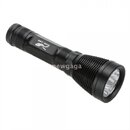I am sorry, I think I am the one stirred up the pot. Sorry for all the technical details and measurement number. The main problem in dive light manufactures is lack of understanding of the LED diode spec for most.
Ideally, one would take every light he/she is interested in to the environment he/she plan to dive for a test run. This unfortunate isn't practical for most if not everyone. So buyer usually reply on manufacture spec, and or word of mouth, or feedback from other users (say here). If you are the potential buyer spent $500 on a Viz 35 think you got 3500 Lumen, but when you put it next to a DRIS1K or DGX600, $80 lights, you find Viz35 is just marginally brigher, I am sure you will regret spending that $500. How about Viz35 next to a LD15 @1500 lumen ($1000) but significantly brighter?? For those who don't mind, please ignore my comments all together. I am just pointing out facts to those who want to know what they are getting for the money.
Back to Viz35 a little. I just watch AG's video. I do NOT think he intentionally lie about output, but rather, he has a wrong understand about lumen. He keep mentioning 3500lumen at 1 meter. I think what he really means is 3500 lux at 1m. Because lumen is total amount of light, it only depends on the light. Distance to measure isn't a function of this number. 3500lux at 1m is a very reasonable number for a well focus Cree XML light, but it isn't anything to ride home on. A typical 21W HID will can do 20,000 lux at 1m
---------- Post added July 16th, 2015 at 11:11 AM ----------
Just read the Cree XML data sheet. The highest LM bin, U2, produce 300lumen at 0.7A. That is their nominal design operation point. Max current supported is 3A. You get 325% of lumen value. So at 3A, you get 975lumen, still shine of 1000, but I call it close enough. I can see many quote against this spec, including DRIS1000 3C, DRIS 1K 3AA, Morph1000. But 3A coming out of 3C or 3AA in series, or 1 18650 is just not possible. And even if you can, driving this Cree at 3A is like driving you car at its top speed. A lot of thing needs to go right for this to happen. Not to mention, it won't be too reliable.





